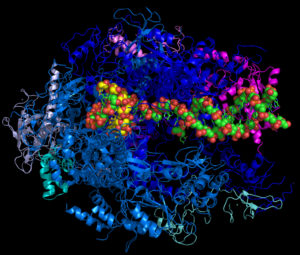
The process of transcription is extremely complex, requiring the well-coordinated interactions of numerous modulatory proteins and protein complexes. Two key players in this process are cyclin-dependent kinase (CDK)7 and CDK9, both of which phosphorylate multiple sites on RNA polymerase II (Pol II), the primary protein responsible for transcription in eukaryotes, as well as on other proteins that regulate Pol II’s activity. One function of CDK7 is to phosphorylate the C-terminal domain (CTD) of Pol II at Ser-5 and Ser-7 as part of a process that causes the enzyme to stall in the promoter region of the gene during transcription initiation. This promoter-proximal pausing helps to coordinate capping of the 5′ end of the nascent mRNA with transcription elongation. In contrast, CDK9 phosphorylates the CTD of Pol II at Ser-2, helping to release the enzyme from promoter-proximal pausing so that transcription can proceed. To better understand exactly how these two kinases coordinate transcription initiation and elongation, Vanderbilt Basic Sciences investigator Scott Hiebert and his lab explored the effects of highly potent and specific inhibitors of CDK7 and CDK9 in acute myeloid leukemia (AML) cell lines and primary leukemic cells from AML patients. They discovered that THZ1, an inhibitor of CDK7 was highly toxic to the cells, whereas PHA767491, an inhibitor of CDK9 was only toxic at very high concentrations. Precision global run-on transcription coupled with deep sequencing (PROseq) enabled the investigators to directly study the effects of each inhibitor on the progress of Pol II along the gene. They discovered that PHA767491 caused a marked increase in promoter-proximal pausing and a loss of Pol II associated with the body of the gene. THZ1 exposure caused essentially the opposite effect. Further studies suggested that THZ1 exposure caused a rapid release of Pol II from the promoter with re-initiation of transcription later without a pause. When the researchers focused their attention specifically on enhancers, they found that PHA767491 had similar effects as were observed in genes whereas THZ1’s effects were varied, causing increased Pol II levels in some enhancers and decreases in others. Evaluation of transcription dynamics suggested that exposure to THZ1 led to alterations of Pol II at the initiation of transcription that not only released it from pausing but also affected the rate of elongation over the course of the entire gene body. In particular, a slowing of elongation near the end of the last exon led to an accumulation of the enzyme in that gene region. In conclusion, the results of these studies were consistent with prior knowledge about the role of CDK7 and CDK9 in modulating the promoter-proximal pause and release of Pol II during transcription initiation. The research also revealed that CDK7 plays a role in polymerase dynamics, in that inhibition of the kinase led to a reduced elongation rate and failure of “read through” at the gene terminus. These new insights provide a critical foundation for understanding the effects of CDK inhibitors, which are promising therapeutic agents for AML and other forms of cancer. Thework is published in the journal Nucleic Acids Research[S. Sampathi, et al. (2019) Nucleic Acids Res., published online February 26, DOI: 10.1093/nar/gkz127].